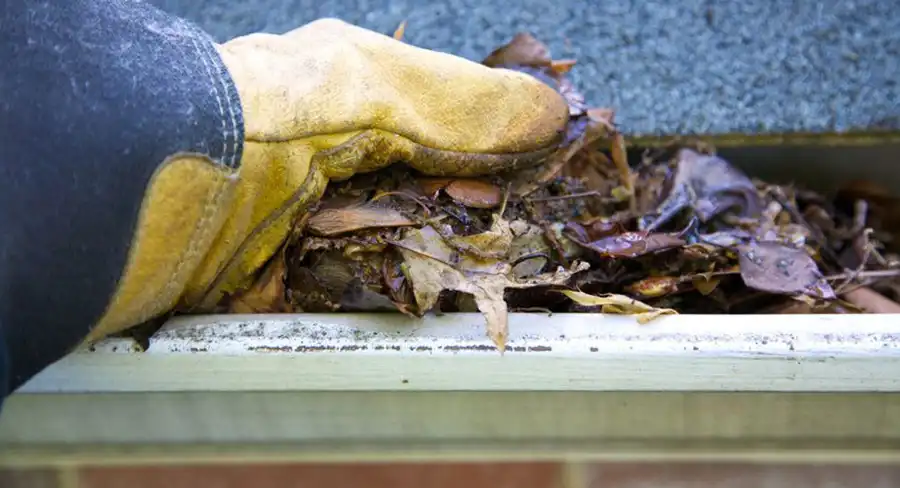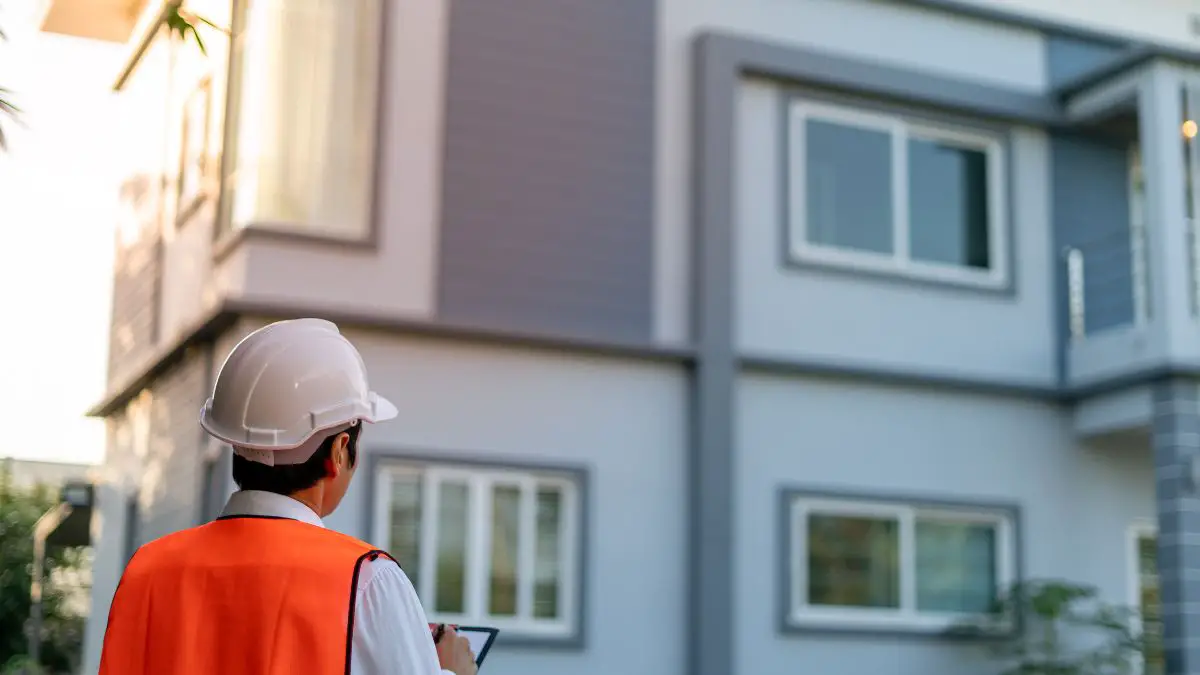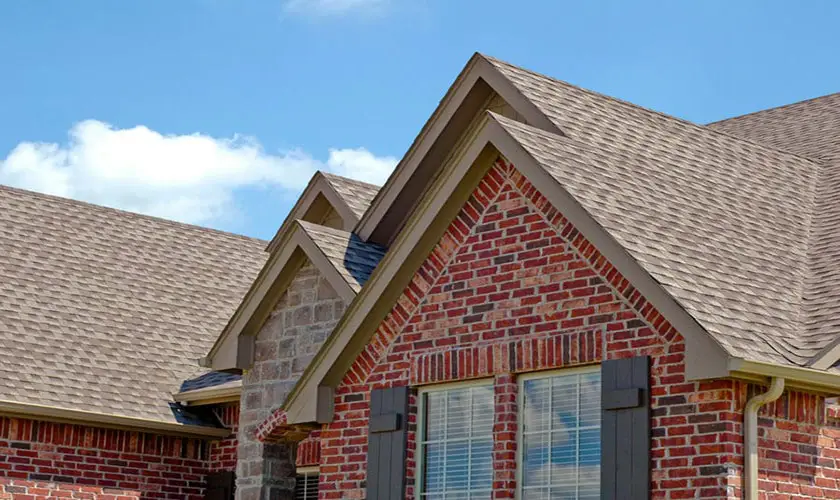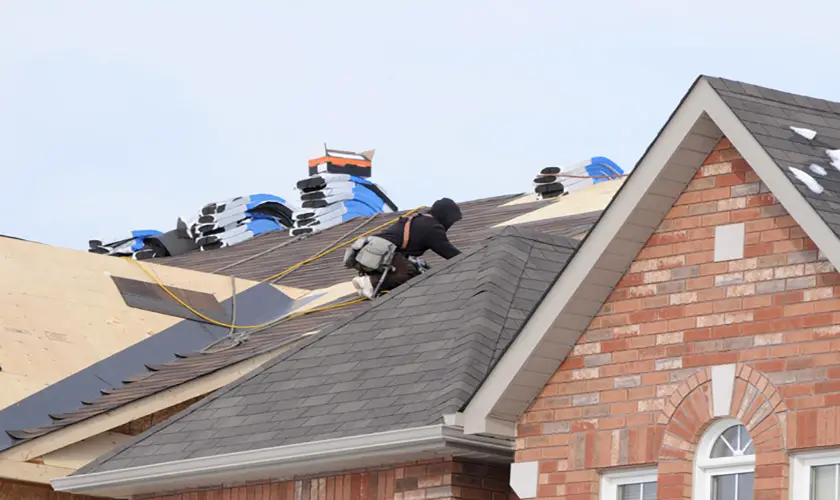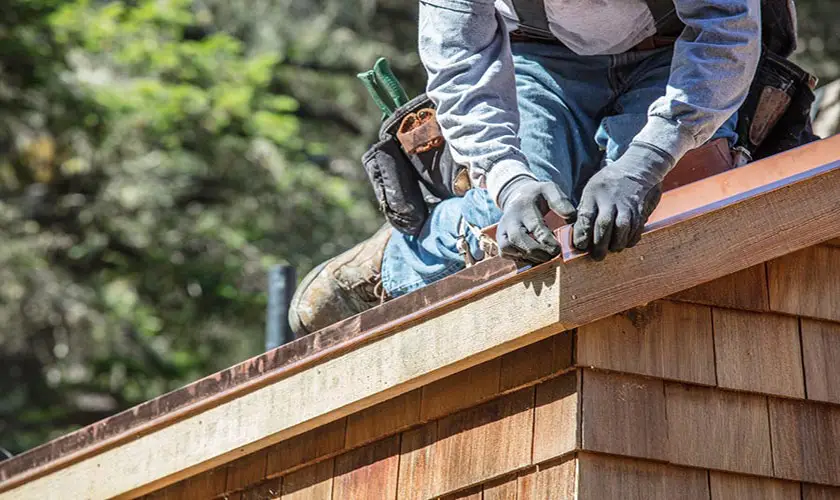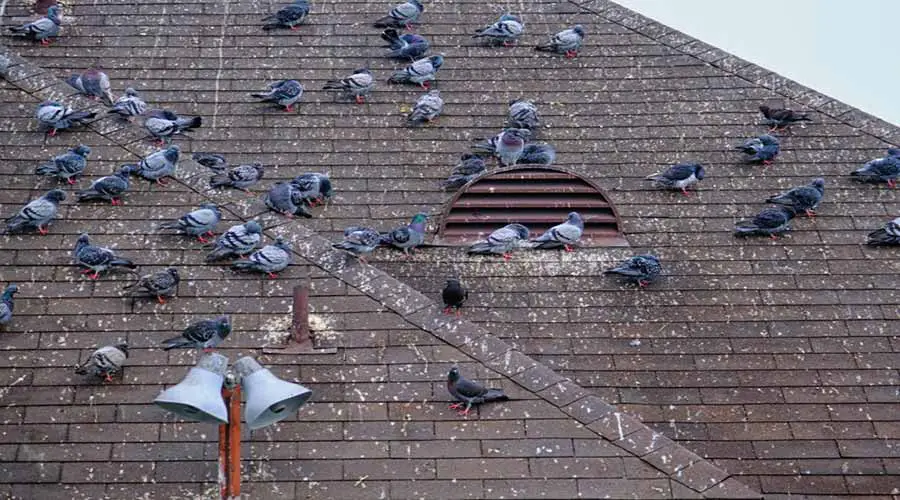
Steep roofs are common in older homes. They’re also common in heavy rainfall areas, heavily wooded areas, and snow-prone locations. However, as modern architecture takes over, flatter roofs and less steep roofs take top priority. The need to direct water away from your landscaping is more prominent with a steeper roof since water flows faster down a steep roof. And that’s why you need gutter guards.
Some gutter guards work with steep roofs, while others don’t perform well. Gutter guards’ primary function is to keep out debris from the gutter. They leave the gutter to only direct water to the downspout and possibly a catchment. You have to consider the amount of rain, the possibility of snow, the roof’s slope, and even the type of foliage.
Are you making the best choice if you buy gutter guards for a steep roof? What are your best options? We’ll answer these and other possible questions about gutter guards.
Take a Vacation from Gutter Cleaning & Save 10% + $325
Can You Put Gutters On A Steep Roof?
If you live in a rain-prone area, you might notice a few things whenever it rains.
- The house’s foundation gets flooded
- Your basement might get flooded
- The landscape near your home is totally defaced
- The soil around your home thins out over time.
It may not seem like it, but these are the long-term consequences of rain coming down your roof and hitting the bare surface near your home. The after splash defaces the side of your home too.
Gutters protect your home from the vulgarities of rain by directing the water away to one location and reducing the intensity of water flow. Gutters will also protect your home’s siding and fascia from long-term damage.
A steep roof is a prime candidate for gutters if a normal roof needs gutters. See, water gathers speed as it comes down a steep roof. A torrential downpour during the rainy season can be terrible for your home when you have a steep roof since the water comes down even heavier. A gutter becomes a necessity in such a setting.
Factors To Consider When Installing Gutters On A Steep Roof
1. The Roof’s Pitch
Installing a gutter for a steep roof means the roof’s pitch is the first thing you should examine. A higher pitched roof means water comes down the roof much faster. An average gutter would spill all the water or cave in after a heavy downpour due to the weight of continuous water.
You have to adjust the measurements according to the height and slope of the roof. A long, excessively steep roof (say, 18/12) needs a deep and wide gutter to keep up with the runoff.
2. Speed of Water
Steeper roofs mean water comes down much faster. Snow also drips much faster on a steeper roof. As such, you’re looking at two different factors when you install gutters to account for water speed.
- You’ll need a durable material.
- You’ll need big gutters.
You might even need to install gutters with a longer front lip to ensure the water stays within the gutter.
3. Strength of the Gutter
When it comes to gutter strength, you’re looking at how to secure your gutters in place. It would be best if you got strong nails and braces. You might also need to space each brace closer to each other to make the gutter stabler and prevent sagging.
4. Width of the Gutter
Gutter width of one of the most critical factors. Six-inch gutters work better than four-inch gutters. 6-inch roofs even work with roofs where the roof has more overhang. The width accommodates more dirt and rainwater.
5. Depth of the Gutter
You might need a deeper gutter to keep up with the runoff from a steeper roof. A professional installer can custom-fit a gutter specific to your roof’s pitch. Deep gutters will carry more water, which means you need to invest in the best material to accommodate the extra weight and pressure during heavy rains.
6. Sufficiency of Downspouts
Finally, ensure enough downspouts to manage the water coming into the gutters. You risk standing water and gutter overload if you don’t have enough downspouts to dispose of the runoff from a steep roof during heavy rain or snowfall. You also have to pay attention to the downspout size. A 3×4 downspout disposes of more water than a 2×3. However, these are measurements you consider knowing how much rain you expect.
Once you have the perfect gutter in place for your steep roof, you need to have a debris management solution.
Debris piles up in the gutter, causing the gutters to clog. A clogged gutter can deface your roof and ruin your home’s aesthetic. It could hang from bearing the weight of months worth of dirt and shedding. It could hold water for a long time and become a host for insect breeding. It can also be a prime spot for mildew and algae, which might spread to other areas of your roof.
Does Leaf Filter Work On Steep Roofs?
Leaf Filter is a perforated screen guard that keeps your gutter debris-free. It uses some of the strongest material and keeps most debris out owing to its micromesh design. It works great with most roofs. However, it’s not the best anti-debris gutter guard for steep roofs.
This is why Leaf Filter isn’t the best choice for a steep roof:
1. Flat gutter guards are terrible for steep roofs.
Leaf Filter is flat. Also, the perforations are quite small. When debris accumulates on the top part of the outer lip of the Leaf Filter, it creates a barrier. Now, water comes from the roof at high speed, hits the barrier, and bounces back to the fascia.
Over time, the wooden fascia will soak the water and rot internally. You will not notice it immediately, especially if you don’t maintain the gutters frequently.
The solution to flat Leaf Filter installation would be to pitch it according to the roof’s slope such that the gutter’s angling absorbs the force of the water. This brings us to a second problem.
2. The micromesh is too fine.
The high speed of the water will glide on the surface of the fine micromesh. Assume you live in an area with wide-leaf trees. The leaves cover the gutter and create a barrier where the water skirts across their surface and doesn’t end up inside the gutter. It defeats the purpose of the gutter guard, and you end up with a flooded landscape.
But you can solve these problems with correct installation.
How To Install A Gutter Guard For Steep Roofs
The first step in installing gutter guards for steep roofs is to get the right gutter guard size. As we mentioned, 6 inches is the perfect size for most steep roofs. However, even with the right size, you can still get it wrong. Why? Angles count for a lot.
Angle the gutter guard such that its back edge is behind the roof, and the front lip lines up with the edge of the roof. There shouldn’t be any gap between the gutter guard’s front frame and the gutter.
Choose between sliding the gutter guard under the roof shingle or bending the mesh down and nailing it to the fascia board.
Sliding the gutter guard mesh into the shingle has the disadvantage of voiding your roof’s warranty since it displaces a portion of the roof. Also, it leaves the underside exposed to the risk of ice dams and water backflow.
Therefore, bend the mesh inwards, angle it to match the roof’s slope, and nail it to the fascia board.
If you have to slide the gutter guard under the roof shingle, ensure the shingle doesn’t curve upwards. The shingle needs to stay straight. Bend the guard’s end that goes into the shingle so that the shingle sits straight on it.
Finally, ensure that the gutter guard has a slight dip into the gutter trough to account for extra water into the gutter. Most gutter guards have flexible material that you can bend into the gutter. It’ll prevent backsplash if there is excess runoff from the roof.
Caution: Bending the gutter guard might create a space for trapped debris. Make sure you check how much debris accumulates in the small dip after every downpour.
Factors To Consider When Putting Gutter Guards In Steep Roofs
You don’t have many open choices when installing gutter guards for steep roofs. However, the limited options you make will either prove to be successful or cost you more money in fascia repair or landscaping.
Use the Right Material
Dealing with the weather can set you up for some major surprises. Therefore, choosing gutter guards for steep roofs with the materials involves three categories.
- Durable
- It can withstand water exposure
- Strong enough to support heavy debris buildup
Aluminum screen guards and stainless steel gutter guards are the best materials you can find for steep roofs. Both do exceptionally well in keeping up with harsh external weather, and most external construction metals are made from aluminum and stainless steel.
These metals have good water resistance capacity, are light enough to allow installers to work with them, and can stay on the roof for years without much damage.
Pick the Best Perforation
Consider the perforation size even when choosing aluminum or stainless steel gutter guards. The goal is to keep debris out and water in the gutter. When you account for the speed of the water running down the steep roof, assume most of the debris will end up on the gutter.
Gutter guards with ultra-fine perforation might work with less steep roofs. You’ll need perforations that allow more water in. Chicken mesh size perforations could work. They will keep larger debris out, let water in, and they’re easy to clean.
Also, chicken mesh-sized perforations will let in finer shingle grit. It might take a while to buildup enough to cause real problems. You can handle the grit problem through the bi-annual gutter cleanup.
Use Flexible Gutter Guards
Flexible gutter guards are purely for easy installation. Ensure you have gutter guards you can adjust once you start the installation. Alternatively, the professional installer will give you their professional insight, which you can do.
Avoid These Gutter Guards For Steep Roofs
Screen guards and micromesh filters work well as gutters for steep roofs. However, avoid brush inserts and foam inserts. Brush inserts and foam inserts aren’t entirely ineffective against steep roofs. The main problem with these gutter protection methods is their vulnerability to roof oils and tiny debris.
Steep roofs tend to be larger. Therefore, they have a proportionate amount of oils and dispose of more fine shingle grit than your average roof.
Every gutter guard solution is an investment in your time and money. Foam inserts and brush inserts might not be that pricey, but investing in a long-term solution and reducing cleaning time makes more sense.
Is There A Downside To Gutter Guards?
There are pros and cons to gutter guards. If you got gutter guards with the intention of relegating gutter cleaning duties to the never pile, you might be disappointed.
You’re not free from gutter cleaning. Shingle grit, tiny twigs, and decaying leaves go through the gutter guards and lodge in the gutter. If rainwater doesn’t wash them away, they will stay there until you clean them out. Unfortunately, too much neglect can cause excess weight to the gutter. The gutter hangs, and it ruins your fascia.
Gutter guards don’t keep 100% of debris out. The tiny leaf bits, shingle oils, and grit that make it past the gutter guards end up in the gutter. It becomes an excellent place for moss growth. Again, if you neglect the gutter, the moss reproduces quickly. It might start to rot the gutter from inside, hidden from your view. It’s worse if you live in a woody area with trees because morning dew collects in the gutter, further fueling the growth.
Gutter guards are terrible for winter. If debris is trapped in the gutter, it blocks water. Water freezes over during winter. The weight of the ice leans heavily on the fascia. However, you can stay ahead of the curve if you clean the gutters before winter.
Speaking of snow, consider getting a gutter heating system to prevent snow buildup in the gutter during winter. Also, you may need to install a snow guard to reduce the likelihood of snow wrecking your gutter if it comes down too hard from the roof.
Are Gutter Guards A Waste Of Money?
Ideally, you need to clean your gutters every three months if you live in a heavily-wooded area. You’ll have lots of pines, leaves, and probably dirt, too, clogging your gutters. Gutter cleaning costs about $200, depending on your location and negotiation skills.
The cost of the priciest gutter guard can go up to $1500. Considering you will still have to shell out $400 a year for gutter cleaning services, gutter guards seem like a waste of money. However, it is only a waste of money if you pay too much for the gutter guard installation in the first place. Also, it is a waste of money if you don’t live in an area that sheds too much foliage.
Final Thoughts
Gutter guards will work on any roof if you get the right installer. Insist on getting a professional service because of the risks and technicality involved. While it may cost you more to get gutter guards for your steep roof, you’ll have an easier time and reduced yearly maintenance costs.
Take a Vacation from Gutter Cleaning & Save 10% + $325
Sources:


